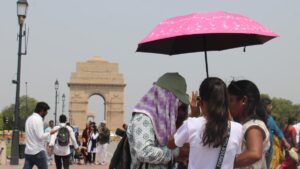 By 2030, major Indian cities such as Mumbai, Chennai, Delhi, Surat, Thane, Hyderabad, Patna, and Bhubaneswar are expected to experience twice the number of heatwave days compared to current levels, according to a study released on June 10, 2025. The report was prepared by development consulting firm IPE Global and GIS technology provider Esri India and launched at the International Global-South Climate Risk Symposium in New Delhi.
By 2030, major Indian cities such as Mumbai, Chennai, Delhi, Surat, Thane, Hyderabad, Patna, and Bhubaneswar are expected to experience twice the number of heatwave days compared to current levels, according to a study released on June 10, 2025. The report was prepared by development consulting firm IPE Global and GIS technology provider Esri India and launched at the International Global-South Climate Risk Symposium in New Delhi.
Titled Weathering the Storm: Managing Monsoons in a Warming Climate, the report presents detailed district-level assessments that reveal a dangerous rise in both extreme heat and unpredictable rainfall across India. The findings highlight the urgent need for localised strategies to build climate resilience in both cities and rural areas.
The report warns that incessant and erratic rainfall will also become more frequent in 8 out of every 10 districts in India, compounding the impact of rising temperatures.
Double burden of heat and rain for many states
States like Gujarat, Rajasthan, Tamil Nadu, Odisha, Uttarakhand, Himachal Pradesh, Maharashtra, Uttar Pradesh, Meghalaya, and Manipur will face the dual challenge of extreme heat stress and heavy rainfall. In fact, more than 80 per cent of the districts in these states could be affected by both threats by 2030, the report noted.
“About 72 per cent of tier-I and tier-II cities will see more cases of heat stress, extreme rainfall, storm surges, lightning, and hailstorms,” said Abinash Mohanty, head of Climate Change and Sustainability Practice at IPE Global and the lead author of the study. He added that global weather patterns like El Niño and La Niña will also intensify, leading to sudden increases in climate disasters such as floods, cyclones, and extreme heat.
Coastal areas will be especially vulnerable, with 69 per cent of coastal districts expected to experience severe heat stress by 2030—a number that could rise to 79 per cent by 2040.
India’s heat crisis worsening over decades
The study found that India has already seen a sharp rise in extreme heat events over the past three decades. Between 1993 and 2024, heatwave days increased by 15 times during the periods of March-May and June-September. The last decade alone saw a 19-fold increase in heatwave days, leading to greater risks for human health, agriculture, energy demand, and water availability.
Changes in microclimates and land-use patterns are making matters worse. In 63 per cent of India’s climate hotspot districts, forests are being cleared, wetlands converted, and farmland replaced by buildings—all of which are breaking natural cooling systems and water cycles.
Local actions can reduce risk
The report recommends that India embrace high-resolution climate risk assessments and create dedicated climate-risk observatories to guide agriculture, industry, and infrastructure projects. “Local factors like deforestation and unplanned urbanisation are magnifying climate risks,” said Mohanty.
“The growing intensity and frequency of extreme heat and rainfall events are no longer rare in India—they’re now part of a new climate reality affecting lives, livelihoods, and cities,” added Agendra Kumar, Managing Director of Esri India. He stressed the importance of GIS-based technologies for real-time climate risk monitoring and better planning.
Proposed solutions
To address these challenges, the report suggests setting up a national Climate Risk Observatory a platform that uses satellite data and climate models to offer real-time warnings and risk forecasts. This could help local authorities improve public communication and target investments for climate-proof infrastructure.
The report also calls for the appointment of “heat-risk champions” in every district disaster management committee to strengthen emergency preparedness at the grassroots level.
Need for climate financing
Beyond technology and governance reforms, the study urges the development of financial tools to reduce the economic damage from climate-related disasters.
“Climate action and economic development cannot be separated anymore,” said Ashwajit Singh, Founder and Managing Director of IPE Global. “India must bring innovative solutions from the margins into the mainstream if it wants to become a global leader in climate resilience.”
Released just as India prepares for the SB 62 climate talks under the UN Framework Convention on Climate Change in Bonn, the report makes a strong case for shifting from reactive disaster management to proactive, data-driven climate planning.
